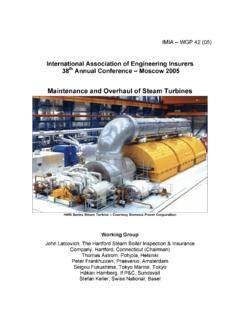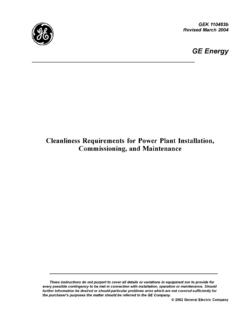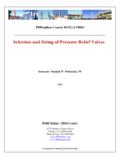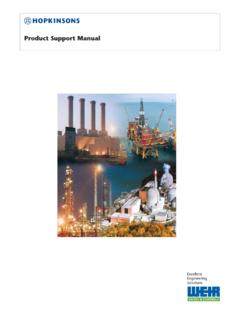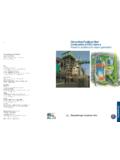Transcription of Maintenance and Overhaul of Steam Turbines WGP42 05
1 IMIA WGP 42 (05) International Association of Engineering Insurers 38th Annual Conference Moscow 2005 Maintenance and Overhaul of Steam Turbines HMN Series Steam turbine Courtesy Siemens Power Corporation Working Group John Latcovich, The Hartford Steam Boiler inspection & Insurance Company, Hartford, Connecticut (Chairman) Thomas strom, Pohjola, Helsinki Peter Frankhuizen, Praevenio, Amsterdam Seigou Fukushima, Tokyo Marine, Tokyo H kan Hamberg, If P&C, Sundsvall Stefan Keller, Swiss National, Basel IMIA WGP 42 (05) 2 Maintenance and Overhaul of Steam Turbines Table of Contents Section Title Page Table of Contents 2 Executive Summary 4 1. Introduction 5 2.
2 Steam turbine Component Characteristics, Failure 6 Mechanisms, Arrangements and Applications A. turbine Component Characteristics and Failure Mechanisms 6 Steam turbine Blading 6 Discs, Rotors, Shafts, Blade Rings, Shells, and Diaphragms 7 Rotor Forgings with Center Bores 8 Bearings and Lubrication Systems 8 Steam and Oil Seals 9 Stop, Trip & Throttle, and Intercept Valves 9 Governor/Control Valves 10 Admission, Extraction, and Non-Return Valves (NRV) 10 Steam Line Connections and Drains 11 turbine Overspeed Protection and Trip Logic 11 B.
3 Steam turbine Arrangements and Applications 12 Type of Steam 12 Exhaust System Configuration 13 Grouping and Number of turbine Stages 14 turbine Arrangements 15 Single Stage Small Steam Turbines 16 Multistage Medium Size Steam Turbines 16 Single Casing Admission/Extraction Multistage Steam Turbines 17 Single Casing Non-Reheat Multiple Stage Steam Turbines 18 Single Casing Reheat Multiple Stage Combined Cycle Steam 18 Turbines Multiple Casing Multiple Stage Reheat Steam Turbines 19 IMIA WGP 42 (05) 3 Table of Contents (Continued) Section Title Page 3.
4 Monitoring, Operations, Maintenance , and 20 Training Infrastructure A. Monitoring 20 Equipment Monitoring 20 Water and Steam Purity Monitoring 22 Water Induction Monitoring 22 Condition Monitoring 23 B. Operations, Maintenance , and Training Infrastructure 24 Operations 24 Maintenance Management 25 Training 25 4.
5 Steam turbine Availability and Failure Experience 27 5. Scheduled Maintenance and Overhaul Practices 30 A. Maintenance Practices 30 B. European Maintenance Practices 32 C. Japanese Maintenance Practices 34 6. Approaches/Methodologies/Criteria for Establishing Longer 37 Time Intervals between Major Overhauls A. Management Directed Interval 37 B. Process and Criticality Driven Intervals 37 C.
6 turbine Manufacturer s Intervals 38 D. Electric Power Research Institute (EPRI) 38 E. VGB Standards 39 F. Risk-Based Methodologies 39 G. Reliability Centered or Condition Based Maintenance 41 (RCM or CBM) 7. Issues with New Steam turbine Technologies and 43 Applications 8. Conclusions 46 IMIA WGP 42 (05) 4 Executive Summary Steam Turbines provide a means of converting saturated, superheated, or supercritical Steam from boilers or heat recovery Steam generators (HRSG) into rotational torque and power.
7 Consequently Steam Turbines are utilized to drive a variety of equipment types of numerous sizes and speeds in just about every industry segment including power generation, pulp and paper, iron and steel, combined heat and power, and chemical, oil and gas industries. While there are substantial differences in the design, complexity, application, Steam conditions, and size of Steam Turbines , they all are fundamentally the same. They perform the same function, utilize similar major components and supporting systems, and are subjected to the same failure mechanisms. To support reliable turbine operation, there needs to be an effective infrastructure in place for monitoring the operating conditions, water/ Steam quality, and health of the Steam turbine , for having and using written operating/ Maintenance procedures, for utilizing a Maintenance management system to schedule/track Maintenance , and for conducting training for personnel on an ongoing basis.
8 There have been numerous causes of Steam turbine failures worldwide. The highest frequency events have been loss of lube oil incidents while the highest severity events have been overspeed events. Typically, higher frequency and higher severity events have been blade/bucket failures, particularly in the low pressure (LP) section of the turbine where the blading experienced a number of failure mechanisms (stress corrosion cracking (SCC), erosion, foreign object damage (FOD)) which ultimately led to failure. With regards to Maintenance practices in North America and Europe, there are no regulatory Maintenance practices or intervals specified for non-nuclear Steam Turbines regardless of the industry or application. As such, the frequencies and tasks are defined by the turbine manufacturers, consultants, industry organizations, plant personnel, plant process requirements, or insurers based on past experience.
9 In Japan, however, there are regulatory requirements for periodic Maintenance . However, regardless of the area of the world, the recommended scheduled Maintenance requirements for Steam Turbines are quite similar. For establishing longer time intervals between major Overhaul outages, there are a number of different approaches which are utilized today worldwide. Regardless of the approach, it is important that the methodologies effectively establish the Overhaul intervals based on the highest risk portions of the Steam turbine . The technologies being incorporated into new Steam Turbines are more sophisticated, require operation at higher pressures and temperatures, and generally have smaller clearances to improve efficiency. While these technologies have not caused any large losses, the inherent risk exposures are increasing and the in-service experience with these technologies needs to be monitored.
10 In summary, Maintenance tasks and frequencies should be prioritized towards the portions of the Steam turbine that have the highest risk. This usually means protecting the Steam turbine from overspeeds, water induction, loss of lube oil, corrosive Steam , and sticking valves that could cause major damage to the turbine , and conducting internal inspections of the turbine flowpath, shells and rotors for failure mechanism damage (creep, erosion, corrosion, fatigue, thermal fatigue, SCC) in order to detect the damage early enough to prevent a subsequent major failure. IMIA WGP 42 (05) 51. Introduction Steam Turbines are utilized in numerous industries to drive boiler fans, boiler feed and water pumps, process and chiller compressors, blast furnace blowers, paper mill line shafts, sugar mill grinders, and generators in a variety of industries and applications.
